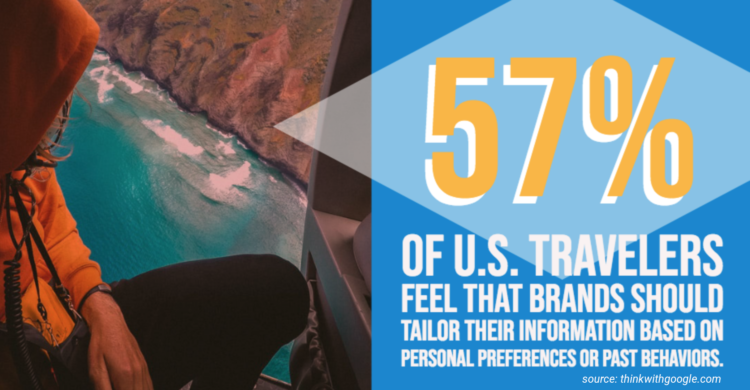According to Think With Google, “37% of travelers in the U.S. think about vacation planning once a month; 17% think about it at least once a week.” This is great news for DMOs looking to attract travelers to their destination. Selecting a destination for travel is all about the right amount of inspiration delivered in your campaign.
When it comes down to it, approaching your DMO’s next ad campaign with similar principles as your content strategy may be the smartest (and most effective) way to ensure you’re inspiring early and often. Here are six things to keep in mind as you craft your next digital ad campaign.
Define content pillars
First things first. Once you’re ready to plan your campaign, the most important next step is defining your content pillars. These are primary topics that can be broken down into many points of activation. Content pillars are essential because they give areas of focus to your foundational content and provide important knowledge to those considering your DMO. (This is true for any content plan, whether or not you’re a DMO.) Key pillars for DMOs often include Food, Entertainment, and Attractions, among others. Make sure all your content ladders up to your marketing strategy and connects to a pillar relevant to your destination. Outlining and focusing on no more than eight pillars from the very beginning will help with making sure your messages aren’t drowning each other out. Bonus points for defining which pillars are most important and relevant to your target audiences.
Key pillars for DMOs often include Food, Entertainment, and Attractions, among others.
Personalize content by audience
A recent study by Google found that “57% [of] U.S. travelers feel that brands should tailor their information based on personal preferences or past behaviors.”
That’s great news if you’re leveraging Facebook or Instagram for your ads, because you have a million and one ways to customize your content to your audience, allowing you to match people to their interests. Match your who with your what to create an emotional connection. For example, customize content for your family audience with family-friendly itinerary ideas, but don’t put this in front of your single, young millennials whose interests are more in line with bars and restaurants. With a robust and well thought-out content strategy, you should have plenty of content to leverage as you go.

Balance inspiring and accessible
Ad content needs to strike a careful balance between awe and attainability. Sure, it’s cool to see what makes a $25,000 taco (yes, that exists), but is it accessible to your target traveler while they’re in town? Will it actually inspire travel? Unlikely. Make sure your content highlights unique attractions/experiences that your target can partake in, and make sure the experiences are identifiable, too. Help your consumer build their itinerary and cement this dream trip to your destination. As you inspire and encourage your target to plan, every piece of content should be usable to create an itinerary for the trip you hope your target will book. Luring them in with a photo that actually made them say “OOOooO” out loud, but not telling them where to find that experience is a missed opportunity and will likely leave your target feeling disappointed instead of eager.
Plan for your target’s planning timeframe
Timing is everything. In the US, “60% of travelers have 30 or more days (42% at 60 or more days) between booking and stay,” which means the inspiration for starting to book happens well ahead of that 30-60 days.
Also, keep in mind that content for a “flight” market will likely need the longest planning runway, pun intended, than content scheduled to the markets that can simply hop in a car and drive to your destination. Those who travel by plane typically plan their trips further in advance. This planning window may vary by market, but a 2-3 month lead time is a good baseline for areas that are further than the driving distance from your destination. Be sure to plan for this as you map your creative needs and content calendar for your marketing efforts so that you’re inspiring with the right content that’s possible to experience in that market’s typical planning window. For example, this will likely mean showing fall images in the summer to your “flight” market. Doing so will help your content align with their planning needs and ensure they have time to plan and experience what you’re featuring.
Use intuitive hashtags
Hashtags don’t necessarily make sense for all ads. But when they do, make sure your hashtags are doing their most. Don’t make UGC (user-generated content) hard to find for those seeking inspiration or a place to add to a feed. #travel[market] is usually a safe bet, otherwise, you’ll be missing out on the word (and pictures and videos) from your fans with the potential to influence countless others. On Instagram, users can follow hashtags for a steady flow of content, making intuitive hashtags all the more important to discover and engage with.
You may be asking, don’t I want my hashtag to be ownable? A feed of content that is primarily brand-curated acts more like a campaign portfolio than an inspirational feed. Keeping the hashtag intuitive provides an opportunity to engage all of your visitors as influencers, and also allows travelers with your DMO in their consideration set to easily stumble upon content that may very well push them to the planning stage.
Review the data
Which ad got the most likes? Friend tags & comments? Link clicks? Average video watch time by market? There are insights waiting to be discovered and leveraged across your business.
These insights can not only come from the ad level but also from the resulting key actions on your site. Which ad got the most newsletter sign-ups? Guide downloads? Booking conversions? Data can (and should) inform future strategies or modify your current plan if you’re nimble enough. It can also inform other areas outside of upcoming ads. Perhaps you find that your family-targeted ads drive the most newsletter sign-ups. That would translate to considering tailoring your newsletter content to ensure it has a family-dedicated section.
The best thing to do is formulate the questions you want answered before you begin. When the questions come first you can structure your ad content for a clean test and ensure your creative is served in a way that shoots back the data you want.
These six components are the building blocks for success, and the right messaging, design, and execution can bring these foundational strategies to life. The common theme across all six is planning. What this means to you is to organize and ensure your content strategy is in place, so that your ads can build upon it. Ask the right questions up front so you can get the results and insights you want.













